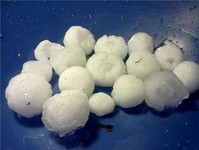Facts About Hail
- The glossary of meteorology defines hail as precipitation in the form of balls or irregular lumps of ice which are always produced by convective clouds. The type of convective clouds are nearly always cumulonimbus, or more commonly, thunderclouds. An individual unit of hail is called a hailstone.
- In general, a hailstone begins as a frozen raindrop or snow pellet within a thunderstorm. The turbulent updrafts and downdrafts within the cloud send the hailstones up and down several times, where they gather layer upon layer of ice. The number of layers in a hailstone reveals the number of up-Down journeys it has made before falling to the earth.
- Recent research, however, has revealed that there is not one simple process of hail formation. Hailstones may actually form in several ways. While most hailstones acquire onion skin layers from traveling up and down in a storm, other hailstones can grow while balanced in an updraft and have little layering. Stones may also form around raindrops that are carried high into the storm and freeze. Finally, some hailstones form around ice crystals. In any case, when the ice at last becomes too heavy to be supported by the updraft, it falls to the ground. Therefore, the stronger the thunderstorm updraft, the heavier weight of hailstones it can support before falling, and the larger the hail may grow.
- A hailstone generally ranges in size from that of a pea to that of a grapefruit, or from about 1/5 inch to more than 5 inches in diameter. Hailstones are usually spherical or conical, but because they form in various ways, a myriad of irregular and fantastic shapes may be created. Some hailstones have been observed to look like pyramids with flattened bases, while others resemble jelly beans. Either while falling or when on the ground, hailstones can melt together and create even more unusual and irregular chunks of ice.
Here are a few interesting facts about hail and hailstones:
- Large hailstones fall at speeds faster than 100 mph.
- Hailstones sometimes contain foreign matter such as pebbles, leaves, twigs, nuts, and insects.
- The largest hailstone observed in the United States fell in Coffeyville Kansas on September 3 1970. The hailstone measured more than 7 inches in diameter, and weighed 1.7 pounds. The previous longstanding record was believed to be a hailstone which fell at potter Nebraska on July 6 1928. It measured around 7 inches in diameter and weighed about 1.5 pounds. In this storm, individual hailstones fell far apart, about 10 to 15 ft from each other.
- Hail causes nearly $1 billion in damage to property and crops annually.
- Costliest United States hailstorm: Denver Colorado July 11 1990. Total damage was $625 million.
- The most deadly international hailstorm on record occurred in india on April 30 1888. This hailstorm killed 230 people at Moradabad, about 100 miles east of Delhi, and 16 others at Bareilly.
Source: NOAA
Get a Free Damage Inspection or Estimate Today!
Quality One Exteriors, LLC
Service Locations:
OHIO
INDIANA
KENTUCKY
TENNESSEE
PENNSYLVANIA
WISCONSIN
KANSAS
MISSOURI
ARKANSAS
NORTH CAROLINA
SOUTH CAROLINA
FLORIDA
Mailing Address
6077 Far Hills Ave. #112
Dayton, OH 45459
Toll Free: 855-314-HAIL (4245)
Corporate: 937-293-ROOF (7663)
Corporate Fax: 937-410-3015
Email:
ContactQ1E@QualityOneExteriors.com
Or simply complete our contact form
Office Hours
M-F 9:00am - 5:00pm
Sat. Hours May Vary
Sun. Closed











